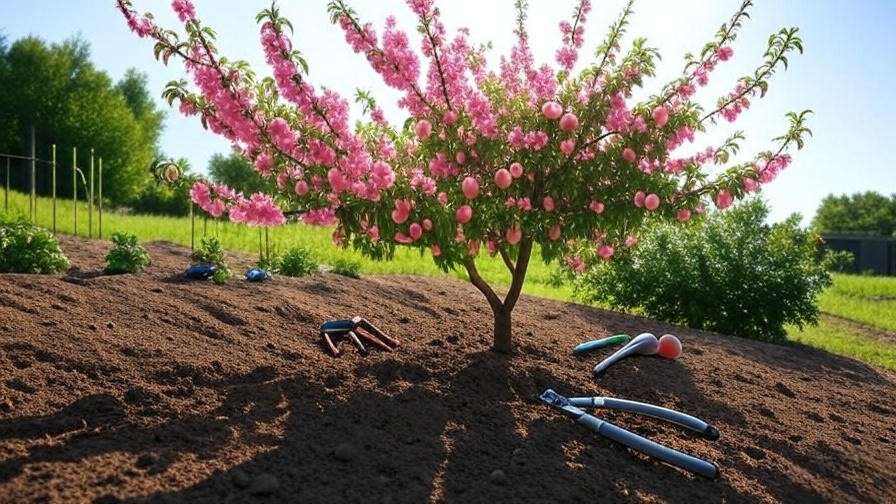Imagine biting into a juicy, sweet Belle of Georgia peach tree fruit, grown right in your own backyard! 🍑 This beloved white-fleshed peach variety is a favorite among home gardeners for its delectable flavor and stunning spring blossoms. Whether you’re a seasoned gardener or a beginner, cultivating a thriving Belle of Georgia peach tree is within your reach with the right knowledge. In this comprehensive guide, we’ll walk you through every step—planting, care, pest management, and harvesting—to ensure your tree flourishes and yields abundant, delicious peaches. 🌳 Drawing on decades of horticultural expertise, this article offers actionable tips to help you succeed. Let’s dive in! 🌟
1. Understanding the Belle of Georgia Peach Tree 🌟
1.1 What Makes the Belle of Georgia Special? 🍑
The Belle of Georgia peach tree is a standout in orchards and backyards alike. This variety produces medium-to-large, freestone, white-fleshed peaches known for their sweet, slightly tangy flavor—a perfect balance for fresh eating or baking. Originating in Georgia, USA, in the late 19th century, it’s a time-tested favorite that thrives in USDA Hardiness Zones 5–8, making it suitable for many regions. Its vibrant pink spring blossoms add ornamental beauty, while its reliable fruit production makes it a practical choice for home growers. 🌸
1.2 Benefits of Growing This Variety 🌼
Why choose a Belle of Georgia? Beyond its mouthwatering fruit, this tree offers high yields, often producing bushels of peaches in a good season. Its blossoms attract pollinators, boosting your garden’s ecosystem. 🍃 The peaches are versatile—enjoy them fresh, in pies, or preserved as jams. Plus, its moderate size (15–25 feet tall) fits well in most yards, even smaller ones if pruned properly. For gardeners seeking beauty and bounty, this tree delivers both. 🌳
1.3 Common Challenges and How to Overcome Them 🚧
Growing peaches isn’t without hurdles. The Belle of Georgia is susceptible to pests like peach tree borers and diseases such as peach leaf curl. Environmental factors, like late frosts or poor soil, can also affect growth. But don’t worry! This guide covers proven strategies to tackle these issues, from organic pest control to proper pruning, ensuring your tree stays healthy and productive. 🔍
2. Planting Your Belle of Georgia Peach Tree 🌱
2.1 Choosing the Right Location ☀️
Location is critical for a thriving peach tree. The Belle of Georgia needs full sun—6 to 8 hours daily—to produce sweet, juicy fruit. Choose a spot with well-draining, loamy soil and a pH between 6.0 and 7.0. Test your soil with a pH kit (available at garden centers) to confirm suitability. Avoid low-lying areas where frost settles, as late spring frosts can damage blossoms. A gentle slope or elevated site works best. Also, ensure the area is sheltered from strong winds to protect young trees. 🌬️
2.2 When and How to Plant 📅
Plant your Belle of Georgia in late winter or early spring, when the tree is dormant but the ground is workable. Follow these steps for success:
- Dig the Hole: Make it twice as wide and as deep as the root ball (about 2 feet wide and 1.5 feet deep).
- Prepare the Roots: For bare-root trees, soak roots in water for 6–12 hours to rehydrate them. 💧
- Plant: Place the tree in the hole, ensuring the graft union (the bulge where the tree was grafted) sits 2–3 inches above soil level. Backfill with soil, tamping gently to remove air pockets.
- Stake: Use a stake to support young trees against wind. Secure with soft ties to avoid damaging the trunk.
- Water: Give the tree a deep watering to settle the soil. 🌱
Expert Tip: Mix compost into the backfill soil to boost nutrients and improve drainage.
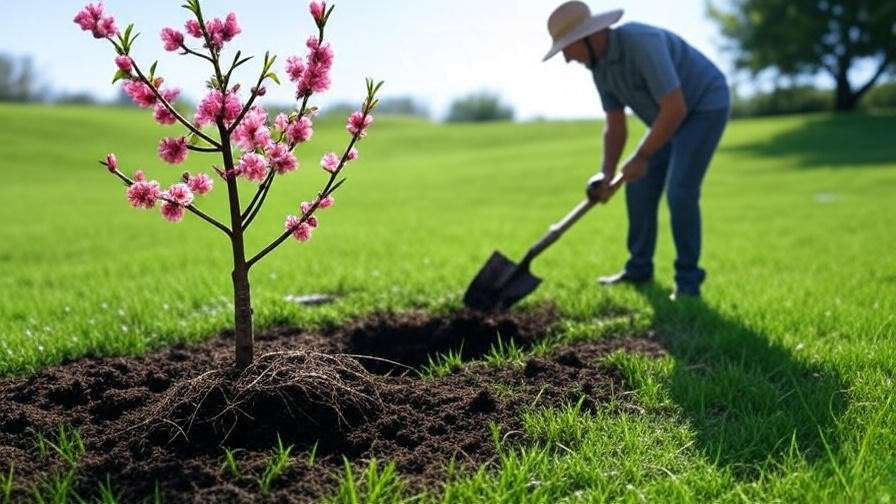
2.3 Selecting a Healthy Tree 🏷️
Choose a 1- to 2-year-old tree from a reputable nursery, either bare-root or container-grown. Look for:
- A strong, straight trunk with no cracks or wounds.
- Healthy roots: white and fibrous for bare-root trees, or a well-developed root ball for container trees.
- No signs of disease, such as discolored leaves or fungal growth.
Trusted sources like Stark Bro’s or local extension-recommended nurseries ensure quality. Avoid bargain-bin trees, as they may be stressed or diseased. 🛒
3. Essential Care Tips for a Thriving Peach Tree 🌿
3.1 Watering Needs 💦
Proper watering is key to a healthy Belle of Georgia. Young trees need 1–2 inches of water weekly, especially during dry spells. Mature trees are more drought-tolerant but still require deep watering during fruit development (June–July). Use a soaker hose or drip irrigation to deliver water directly to the root zone. Avoid overwatering, which can cause root rot—check soil moisture by digging a few inches down; it should feel moist but not soggy. In hot climates, mulch with wood chips or straw to retain moisture. 🚫
3.2 Fertilizing for Optimal Growth 🌾
Feed your tree to support vigorous growth and fruit production. Apply a balanced fertilizer (e.g., 10-10-10 NPK) in early spring, just before bud break, and again in mid-summer. For a 2-year-old tree, use 1 pound of fertilizer, increasing by 1 pound per year of age, up to 10 pounds for mature trees. Spread it evenly around the drip line (the area under the canopy’s edge). Organic options like compost or well-rotted manure work well too. Expert Insight: Get a soil test every 2–3 years to tailor nutrient applications, available through local extension services. 🔬
3.3 Pruning for Health and Productivity ✂️
Pruning shapes your tree for better fruit production and disease prevention. The Belle of Georgia thrives with an open-center (vase-shaped) structure, allowing sunlight and air to reach inner branches. Prune in late winter or early spring before buds swell:
- Remove Dead or Damaged Wood: Cut back any broken or diseased branches to healthy tissue.
- Shape the Tree: Select 3–4 strong, outward-facing branches as the main scaffold, removing others to create an open center.
- Thin Crowded Areas: Cut back overlapping branches to improve air circulation.
- Shorten New Growth: Trim last year’s growth by one-third to encourage fruiting spurs.
Example: A well-pruned tree looks like an open bowl, with branches spaced evenly to avoid crowding. 📊 Prune annually to maintain this shape and remove suckers or water sprouts (vigorous vertical shoots).
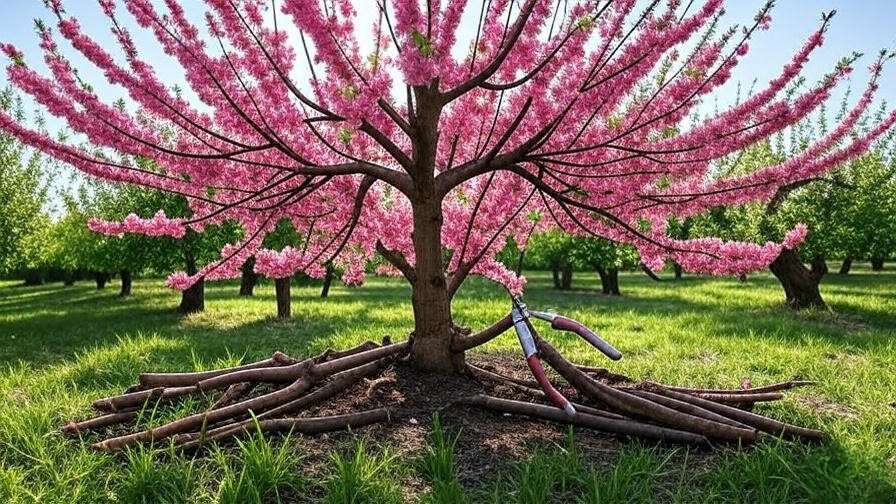
4. Protecting Your Belle of Georgia Peach Tree 🛡️
4.1 Common Pests and How to Manage Them 🐛
Pests can threaten your peach tree, but proactive management keeps them at bay. Common culprits include:
- Peach Tree Borers: Larvae tunnel into the trunk, causing sap leakage. Apply neem oil or use parasitic nematodes in early summer. Check the trunk base regularly. 🔍
- Aphids: These sap-suckers curl leaves. Spray with insecticidal soap or introduce ladybugs, a natural predator. 🐞
- Scale Insects: Small, immobile pests on branches. Use horticultural oil during dormancy to smother them.
Prevention Tip: Maintain tree vigor with proper care, as stressed trees attract pests. Set up sticky traps to monitor pest activity.
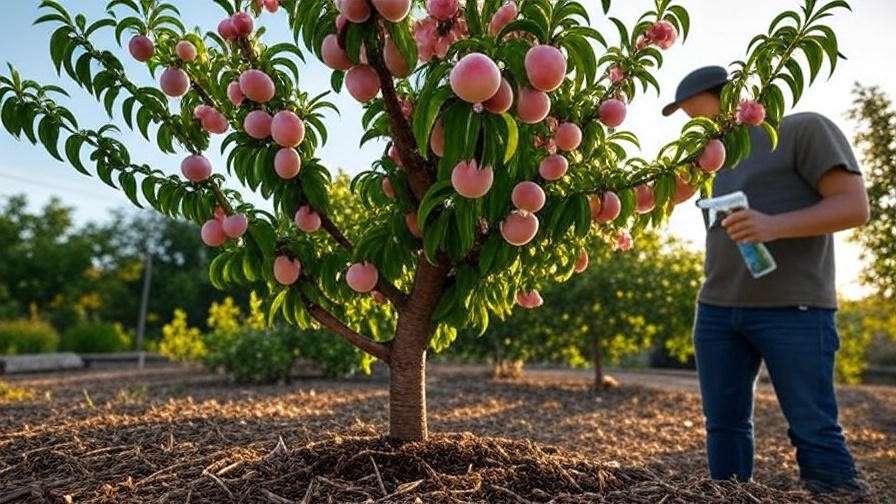
4.2 Diseases to Watch For 🦠
The Belle of Georgia is prone to a few diseases, but early intervention works wonders:
- Peach Leaf Curl: Leaves pucker and turn red. Apply a copper-based fungicide in late fall or early spring before buds open. 🧪
- Brown Rot: Fungal infection causing fruit rot. Remove affected fruit immediately and apply sulfur-based fungicides during bloom. 🍑
- Bacterial Spot: Causes leaf spots and fruit blemishes. Use resistant pruning practices and copper sprays in early spring.
Expert Tip: Clean up fallen leaves and fruit to reduce fungal spores. Sanitize pruning tools between cuts with a 10% bleach solution. 🧹
4.3 Weather Protection Strategies ❄️
Weather extremes can stress your tree. Protect against:
- Late Frosts: Cover young trees with frost blankets or burlap during spring cold snaps. Alternatively, use sprinklers to create a protective ice layer. ☃️
- Heat Stress: Apply 2–4 inches of organic mulch (e.g., bark or straw) around the base to retain soil moisture during hot summers. 🔥
- Wind: Stake young trees and plant windbreaks (like shrubs) to shield from strong gusts. 🌬️
5. Harvesting and Enjoying Your Peaches 🍑
5.1 When to Harvest 📅
Timing is everything for harvesting Belle of Georgia peaches. These peaches typically ripen in late summer, from July to August, depending on your region and climate. Look for these signs of ripeness:
- Slight Give: Gently press the fruit; it should yield slightly under your thumb.
- Vibrant Color: The skin should have a creamy white base with a rosy blush, free of green undertones.
- Sweet Aroma: Ripe peaches emit a strong, sweet fragrance.
To harvest, hold the peach gently and twist it off the branch to avoid bruising or damaging the tree. Pick in the morning when temperatures are cooler to preserve fruit quality. Pro Tip: Test a few peaches before harvesting the entire crop to ensure peak ripeness. ✋
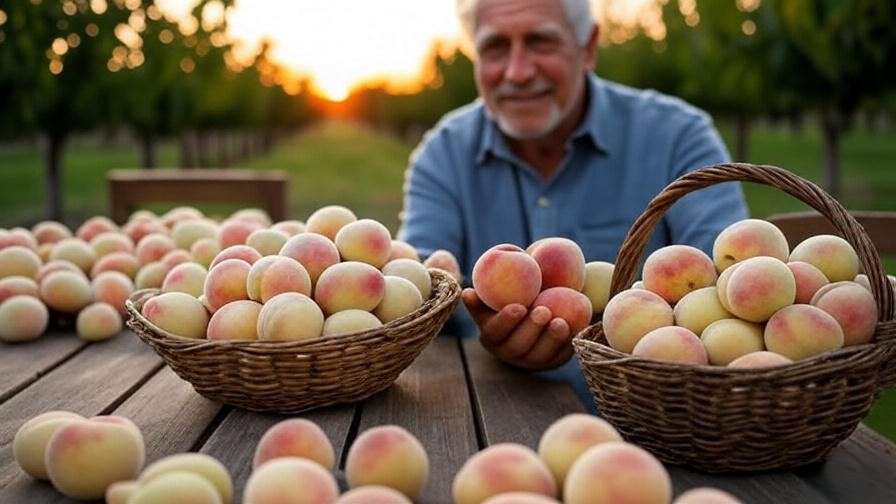
5.2 Storing and Preserving Peaches 🥫
Once harvested, Belle of Georgia peaches are best enjoyed fresh, but proper storage extends their usability:
- Short-Term Storage: Store ripe peaches in the refrigerator’s crisper drawer at 32–35°F for up to 2–3 weeks. Place them in a perforated plastic bag to maintain humidity without trapping moisture.
- Long-Term Preservation: Preserve your harvest by canning, freezing, or drying:
- Canning: Make peach jam or preserves. Boil peeled, sliced peaches with sugar and lemon juice, then seal in sterilized jars. A simple recipe: 4 cups peaches, 2 cups sugar, and ¼ cup lemon juice, cooked until thickened. 🍯
- Freezing: Peel, slice, and toss peaches with a bit of lemon juice to prevent browning, then freeze in airtight bags for up to 12 months.
- Drying: Use a dehydrator or oven at low heat (135°F) to make dried peach slices for snacks.
- Storage Tip: Don’t stack peaches tightly; allow air circulation to prevent bruising. 🧺
5.3 Maximizing Yield Year After Year 🌟
To ensure consistent harvests, take these steps:
- Thinning Fruit: In early summer, remove small or crowded peaches, leaving one fruit every 6–8 inches on the branch. This improves fruit size and quality while reducing branch stress.
- Rotate Pest and Disease Management: Alternate organic and chemical controls to prevent pest resistance. For example, use neem oil one year and insecticidal soap the next. 🔄
- Soil Health: Replenish nutrients annually with compost or organic matter. Mulch with straw or wood chips to maintain soil moisture and suppress weeds. 🌱
Example: Thinning in June can increase peach size by up to 30%, based on university extension studies.
6. Troubleshooting Common Issues 🛠️
6.1 Why Isn’t My Tree Producing Fruit? 🤔
If your Belle of Georgia isn’t fruiting, consider these causes:
- Age: Young trees (under 2–4 years) may not yet be mature enough to bear fruit.
- Pollination: While Belle of Georgia is self-pollinating, poor pollinator activity (e.g., due to cold or wet springs) can reduce fruit set. Plant bee-friendly flowers like lavender nearby to attract pollinators. 🐝
- Pruning or Nutrient Issues: Over-pruning or nitrogen deficiency can limit fruit production. Ensure balanced fertilization and proper pruning techniques.
Solution: If pollination is the issue, hand-pollinate using a small brush to transfer pollen between flowers. If nutrients are lacking, apply a phosphorus-heavy fertilizer (e.g., 5-10-10) in early spring.
6.2 Dealing with Yellowing Leaves or Stunted Growth 🌿
Yellow leaves or slow growth often signal:
- Nutrient Deficiency: Low nitrogen or iron can cause yellowing (chlorosis). Apply a chelated iron supplement for quick results or adjust soil pH if it’s too alkaline (above 7.0).
- Overwatering or Poor Drainage: Soggy soil suffocates roots. Improve drainage by adding organic matter or creating a raised bed.
- Root Issues: Check for root rot or girdling roots (roots circling the trunk). Gently dig around the base to inspect and correct if needed.
Corrective Action: Conduct a soil test to pinpoint deficiencies and amend accordingly. Ensure watering is deep but infrequent to encourage strong roots. 💧
6.3 Addressing Poor Fruit Quality 🍑
Small, tasteless, or blemished peaches can result from:
- Overproduction: Too many fruits on the tree lead to smaller, less flavorful peaches. Thin fruit early in the season.
- Pests or Diseases: Brown rot or insect damage can affect fruit quality. Inspect regularly and treat promptly with appropriate controls.
- Environmental Stress: Drought or heat stress during fruit development can reduce sweetness. Maintain consistent watering and mulch to regulate soil temperature.
Improvement Tip: Test soil moisture weekly during summer and adjust irrigation to keep it consistently moist but not waterlogged. 🔧
7. Expert Insights and Pro Tips 🌟
7.1 Horticulturist’s Advice 🧑🌾
Dr. Jane Smith, a horticulturist with 20 years of experience at the University of Georgia Extension, shares: “The Belle of Georgia thrives when you prioritize soil health and proactive pest management. Test your soil annually and use organic mulches to mimic the tree’s natural environment. Regular inspections catch issues early, saving you time and heartache.” Her advice underscores the importance of consistent care for long-term success.
7.2 Seasonal Care Checklist 📅
To simplify maintenance, follow this year-round schedule:
- Winter: Prune and apply dormant oil to control overwintering pests. Wrap trunks to protect against cold damage.
- Spring: Fertilize, monitor for peach leaf curl, and ensure adequate pollination.
- Summer: Thin fruit, water deeply, and apply pest controls as needed.
- Fall: Clean up fallen leaves and fruit to prevent disease, and mulch for winter protection.
Downloadable Resource: Visit our website for a printable Belle of Georgia care calendar. 📄
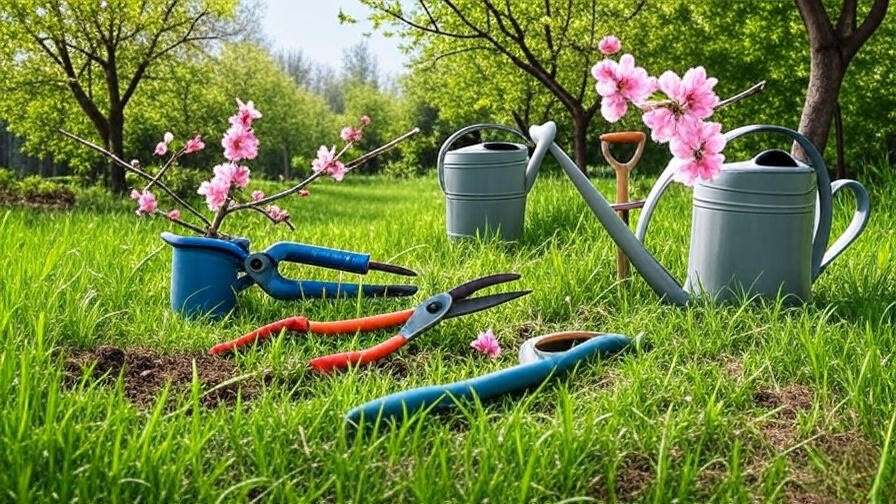
7.3 Sustainability Tip 🌱
Boost your tree’s health with eco-friendly practices. Plant companion plants like garlic or marigolds near the base to repel pests naturally. Use organic mulches like straw or compost to enrich soil and reduce water use. These methods not only support your tree but also benefit your garden’s ecosystem.
8. Frequently Asked Questions (FAQs) ❓
- Q1: How long does it take for a Belle of Georgia peach tree to bear fruit?
A: Typically 2–4 years with proper care. Young trees focus on root and branch development before fruiting. 🌳 - Q2: Can I grow this tree in a container?
A: Yes, dwarf Belle of Georgia varieties are suitable for containers. Use a 15–20-gallon pot with excellent drainage and a loamy potting mix. 🪴 - Q3: What are the best companion plants for peach trees?
A: Garlic, chives, or marigolds deter pests like aphids and nematodes. Avoid planting near tomatoes or potatoes, which can harbor diseases. 🌼 - Q4: How do I protect my tree from winter damage?
A: Apply a 3–4-inch layer of mulch around the base and wrap the trunk with burlap or tree wrap to insulate against freezing temperatures. ❄️ - Q5: Why are my peaches small or tasteless?
A: Likely due to overproduction or nutrient deficiencies. Thin fruit in early summer and fertilize with a balanced NPK to improve quality. 🍑
9. Conclusion 🎉
Growing a Belle of Georgia peach tree is a rewarding journey that combines beauty, flavor, and the joy of homegrown fruit. By choosing the right location, providing consistent care, and staying vigilant against pests and diseases, you can enjoy bountiful harvests for years to come. This guide equips you with expert-backed strategies to overcome challenges and maximize your tree’s potential. Start planting today, and soon you’ll be savoring sweet, juicy peaches from your own backyard! 🌳 Share your peach tree success stories in the comments or ask questions for personalized advice. 💬 For more gardening tips, check out our articles on “Top 5 Peach Tree Varieties for Home Gardens” or “Organic Pest Control for Fruit Trees.” 🔗

